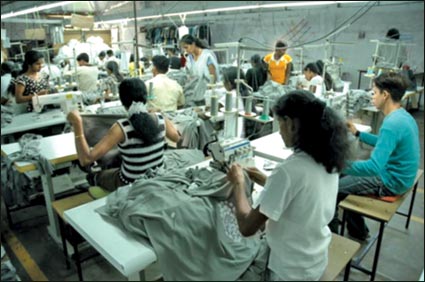|
National Occupational Safety and Health Week:
Collective efforts to ensure workers’ safety
Address by Labour Relations and Manpower Ministry Secretary Mahinda
Madihahewa at the National Workshop held on October 7, 2009 at Colombo
at an event to mark the National Occupational Safety and Health Week
|
Address by Labour
Relations and Manpower Ministry Secretary Mahinda Madihahewa at
the National Workshop held on
October 7, 2009 at Colombo at
an event to mark the National
Occupational Safety
and Health Week |

Mahinda
Madihahewa |
The National Safety Conference is one of the major events of the
Safety Week 2009. This year the theme of the National Conference is
‘Safe Work Promotes Healthy Life’.
As you are aware, the Occupational Safety and Health day is
celebrated globally on April 28. However, given the significance of
occupational safety and health in promoting healthy and quality life in
Sri Lanka, in addition, the Cabinet of Ministers has declared the second
week of October each year as the ‘Safety Week’.
National event
Every year we implement many programs during this week. The National
Conference which is held today is the national event of this safety
week. This year, we have, among other things, organized a workshop to
promote occupational safety and health among mine workers. The workshop
will be held on 12th of this month with the participation of around 250
workers in the Bogala Graphite mine. We have also taken action to issue
a special edition of the Sri Lanka Labour Gazette, development and
distribution of promotional literature and conduct small group
promotional activities throughout the country by the Labour Department.
According to ILO statistics, 2.2 million people die world over due to
occupational accidents and diseases. Some 270 million suffer annually
from serious non-fatal injuries and another 160 million suffer from
short or long-term illnesses from work related causes. The total cost of
such accidents and ill health have been estimated at four percent of the
worlds gross domestic product. ILO statistics also show that more than
four percent of the global GDP is lost due to occupational accidents. In
Sri Lanka about 4,000 accidents have been reported yearly. The number of
working days lost due to accidents is estimated to be around 600,000
workdays every year. According to the Commissioner for Workmens’
Compensation 156 fatal accidents have been reported during the year
2008. The Compensation paid during year 2008 has been reported as Rs.
65,922,095.03.
Economic impact
This is a colossal amount of money and this reflects only the
economic impact of occupational accidents. How about the psycho social
impact of occupational accidents? It is enormous and cannot be
quantified only in monetary terms.
|

Frequent occupational accidents has negative impact on economy.
ANCL Library photo |
As you are aware, around 8.2 million Sri Lankans are economically
active. This is nearly 1/3rd of the population of Sri Lanka. These
people constitute our Labour Force and they are the backbone of our
economy who propel the country towards development. We should not forget
the fact, that every worker who leaves his or her home for work has the
right to return home after work, safely.
Health and safety
One may argue that providing protection to the workers is the
responsibility of the employer, while some may think that it is the
responsibility of the Government. But the employer or the Government
alone cannot ensure health and safety, unless the workers take care of
themselves. It is only through the collective efforts of all of us,
health and safety of the workers could be ensured.
There are three main causes of occupational accidents. Human factor
or unsafe acts; environmental factor or unsafe conditions; and
organizational factor or management factors.
According to research findings, about 80 percent of work related
accidents were due to human error or unsafe acts. Operators’ error has
been identified as the main contributory factor of human error.
Prevention of occupational injuries and occupational diseases is a
multi-disciplinary and multi-faceted exercise. Collective efforts of
occupational physicians, safety engineers, ergonomic specialists,
occupational hygienist and toxicologists are mandatory.
In the Labour Department, three technical divisions are providing OSH
services to industries. They are the Division of Industrial Safety,
Division of Occupational Hygiene and the National Institute of
Occupational Safety and Health. These divisions and National Institute
provide the necessary services.
These services are provided by professional engineers, doctors and
officers who have been trained and have vast experience in OSH.
We have found that the existing legislation on Occupational Safety
and Health is limited in scope and applies only to factories. It covers
around 30 percent of the total workplaces in the country. We are
currently in the final stages of the process of introducing a new
Occupational Safety and Health Law. This new law covers almost all the
workplaces. The new law also will have safety and health standards
relating to a wide spectrum of sectors. The other significant feature of
the new law is the promotion of self regulation.
European countries
A survey carried out recently has revealed that 70 percent of the
consumers in the European countries answered that ‘Protecting health and
safety of its workers’ was an important area for the companies to
support.
The initiative of ‘Responsible care’ is also another voluntary
commitment to improve its performance in respect to safety, health and
environment.
In a globalized economy, self-regulation has become a powerful aid to
the process. I find that the new law is also leading us to new areas of
safety and health. It is self regulation, and also developing a safety
culture within the enterprise. Self regulation also addresses some of
the problems encountered by the enforcement authorities due to resource
constraints. For enforcement of the occupational health and safety law,
we have only a handful of technically qualified persons.
Different strategies
With the new law coming into force we will find that the existing
cadres are extremely inadequate. Therefore, we need to think of
different strategies, different tools and involvement of the services of
different personnel.
One such strategy is to get the services of the Labour Officers. The
integrated Labour inspection system introduced under the modernization
of Labour Relations and Manpower Ministry requires the Labour Officers
to look into the occupational safety and health aspects in the
workplaces. They, of course, may not be able to advise on the technical
aspects. But they could look into the compliance with certain
occupational safety and health standards.
OSH legislation
Their observations could be reported to the Occupational Safety and
Health officers to enable them to carry out technical inspections.
Under the new law, we intend granting authority of enforcement of OSH
legislation to officers of Health Care and Nutrition Ministry. We could
successfully enlist the services of the officers who are involved in
community health activities. There are officers attached to different
Ministries such as the Agriculture Ministry, Fisheries Ministry,
Environment Ministry etc., whose services could be enlisted in the
promotion of OSH in the country.
The Trade Unions and the workers themselves also could closely watch
the situation and bring to the notice of the management or to the
concerned officers.
In order to get the involvement of all the stakeholders in promoting
safety and health in the workplace, we have a major task of creating
awareness among them, empowering them and disseminating information to
them. For this purpose, we have set up the National Institute of Safety
and Health. It has been established under the National Institute of
Occupational Safety and Health Act, No. 38 of 2009.
Occupational safety
The Institute is responsible to design suitable programs to educate
all stakeholders on the significance of occupational safety and health,
training of OSH Officers and setting-up national OSH standards. The
Institute would also act as the centre for networking with organizations
dealing with safety and health world over.
I believe that, it is of paramount importance that employers and
employees prioritize occupational safety and health in their corporate
agenda and make the maximum use of the services provided by the Labour
Department and the National Institute of Occupational Safety and Health.
Collective efforts should be taken by employers, employees and the
Government to achieve highest possible level of occupational safety and
health in our country. Let us make synergies by working together towards
one common objective, that is, promoting health life through promoting
safe work. |



